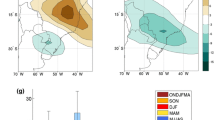Abstract
In this study, various diagnostics have been applied to daily observed outgoing longwave radiation (OLR) and ECMWF ReAnalysis (ERA) products to provide a comprehensive description of the active/break cycles associated with the Asian Summer Monsoon and to address the differing behaviour of the two dominant time scales of intraseasonal variability, 10–20 days and 30–60 days. Composite analysis of OLR based on filtered daily All-India rainfall (AIR) for the 40 day (30–60 days) intraseasonal mode indicates that during active phases, convection is significantly enhanced over the Indian continent, extending over the Bay of Bengal, Maritime continent and equatorial west Pacific, while convection is suppressed over the equatorial Indian Ocean and northwest tropical Pacific, resulting in a ‘quadrapole’ structure over the Asian monsoon domain. In response to this heating pattern, the large-scale Hadley (lateral) and the two east-west (transverse) tropical circulations are enhanced. There is also a significant impact on the extra-tropical circulation through excitation and propagation of Rossby waves. In contrast, the 15-day mode is more regional to the monsoon domain and has a prominent east-west orientation in convection. Only the local Hadley circulation over the monsoon region is modulated by this mode. The evolution of these two modes as revealed by POP (principal oscillation pattern) analysis, shows that the 40-day mode originates over the equatorial Indian Ocean. Once formed it has poleward propagation on either side of the equator, and eastward propagation into the equatorial west Pacific. From the equatorial west Pacific, northward propagation over the west Pacific and westward propagation into the Indian longitudes are prominent. The propagative features are complex and interactive and are responsible for the ‘quadrapole’ structure in convection seen from the composites. The interannual variability, assessed from the POP coefficient time series, indicates that the 40-day mode is strong during the onset phase of the monsoon in all the years but systematic propagation over the entire season depends crucially on the activity of the oceanic TCZ (tropical convergence zone). The POP analysis of the 15-day mode indicates that this event originates over the␣equatorial west Pacific, associated with westward propagating Rossby waves, amplifies over the northwest tropical Pacific and modulates both the continental and oceanic TCZs over Indian longitudes simultaneously. This mode is pronounced during the established phase of the monsoon. Due to the complexity in the propagational features of both the intraseasonal modes, it is concluded that understanding the subseasonal variability of one regional component of the Asian Summer Monsoon (ASM), requires understanding the entire ASM system.
Similar content being viewed by others
Author information
Authors and Affiliations
Additional information
Received: 22 June 2000 / Accepted: 30 January 2001
Rights and permissions
About this article
Cite this article
Annamalai, H., Slingo, J. Active / break cycles: diagnosis of the intraseasonal variability of the Asian Summer Monsoon. Climate Dynamics 18, 85–102 (2001). https://doi.org/10.1007/s003820100161
Issue Date:
DOI: https://doi.org/10.1007/s003820100161




